Tascam Model 24 Users Manual
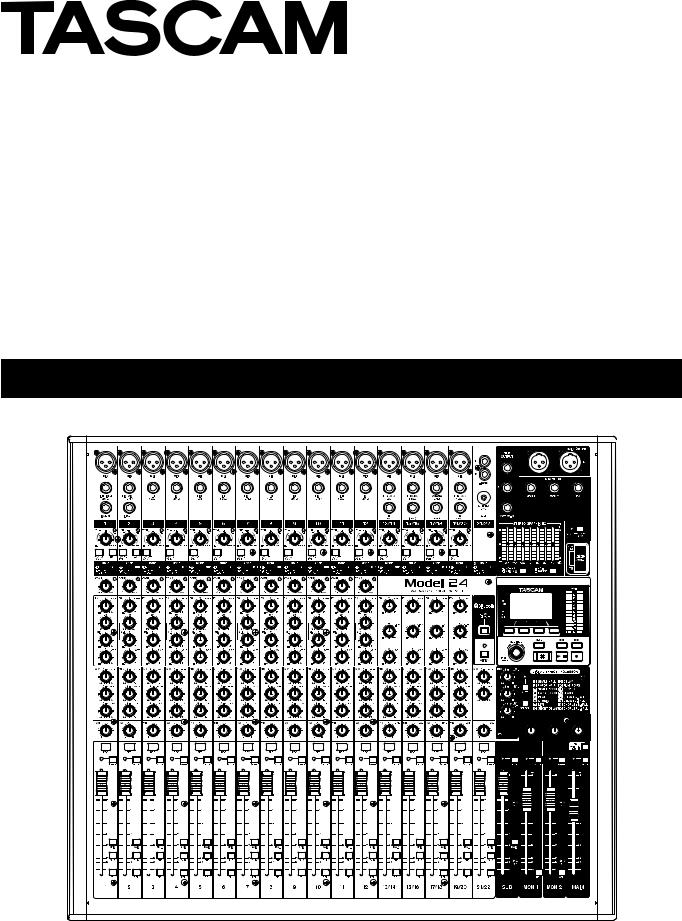
042862000
Model 24
Multitrack Live Recording Console
OWNER'S MANUAL
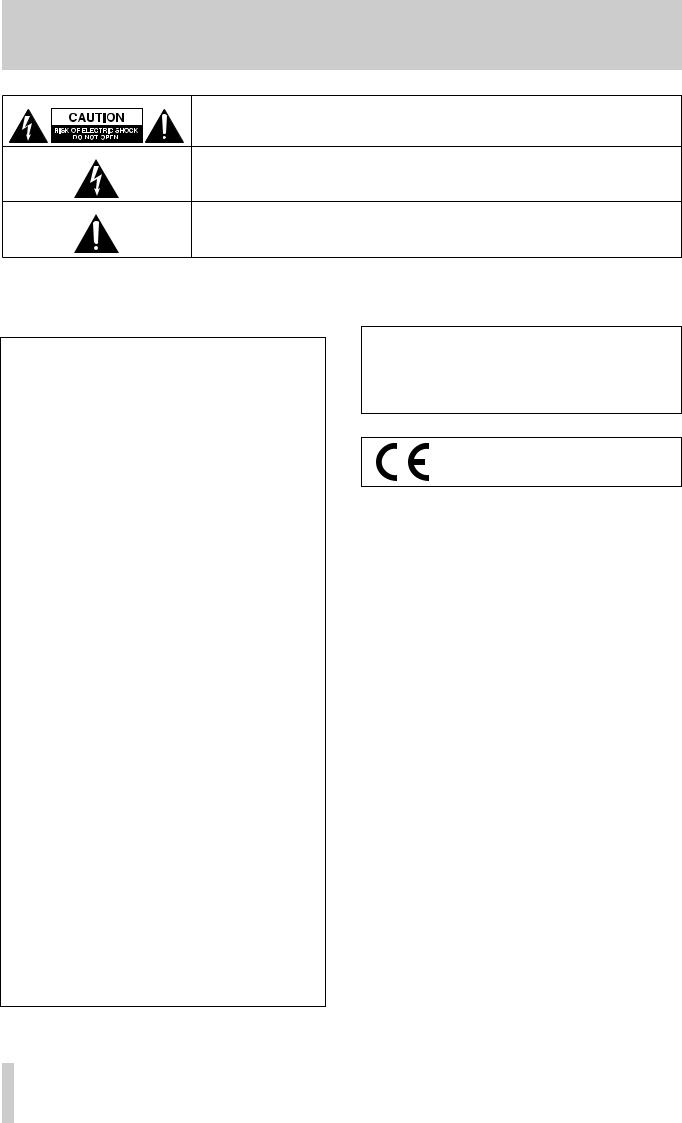
IMPORTANT SAFETY PRECAUTIONS
CAUTION: TO REDUCE THE RISK OF ELECTRIC SHOCK, DO NOT REMOVE COVER (OR BACK). NO
USER-SERVICEABLE PARTS INSIDE. REFER SERVICING TO QUALIFIED SERVICE PERSONNEL.
The lightning flash with arrowhead symbol, within equilateral triangle, is intended to alert the user to the presence of uninsulated “dangerous voltage” within the product’s enclosure that may be of sufficient magnitude to constitute a risk of electric shock to persons.
The exclamation point within an equilateral triangle is intended to alert the user to the presence of important operating and maintenance (servicing) instructions in the literature accompanying the appliance.
WARNING: TO PREVENT FIRE OR SHOCK HAZARD, DO NOT |
|
IN USA/CANADA, USE ONLY ON 120 V SUPPLY. |
EXPOSE THIS APPLIANCE TO RAIN OR MOISTURE. |
|
|
|
|
|
|
|
|
For U.S.A.
Declaration of Conformity
Model Number: Model 24 Trade Name: TASCAM
Responsible party: TEAC AMERICA, INC.
Address: 10410 Pioneer Blvd., Unit #1 and #4, Santa Fe Springs, CA 90640, U.S.A.
Telephone number: 1-323-726-0303
This device complies with Part 15 of the FCC Rules. Operation is subject to the following two conditions: (1) this device may not cause harmful interference, and (2) this device must accept any interference received, including interference that may cause undesired operation.
INFORMATION TO THE USER
This equipment has been tested and found to comply with the limits for a Class B digital device, pursuant to Part 15 of the FCC Rules. These limits are designed to provide reasonable protection against harmful interference in a residential installation. This equipment generates, uses, and can radiate radio frequency energy and, if not installed and used in accordance with the instruction manual, may cause harmful interference to radio communications. However, there is no guarantee that interference will not occur in a particular installation. If this equipment does cause harmful interference to radio or television reception, which can be determined by turning the equipment off and on, the user is encouraged to try to correct the interference by one or more of the following measures.
a)Reorient or relocate the receiving antenna.
b)Increase the separation between the equipment and receiver.
c)Connect the equipment into an outlet on a circuit different from that to which the receiver is connected.
d)Consult the dealer or an experienced radio/TV technician for help.
CAUTION
Changes or modifications to this equipment not expressly approved by TEAC CORPORATION for compliance could void the user’s authority to operate this equipment.
For Canada
THIS CLASS B DIGITAL APPARATUS COMPLIES WITH CANADIAN ICES-003.
CET APPAREIL NUMERIQUE DE LA CLASSE B EST CONFORME A LA NORME NMB-003 DU CANADA.
This product complies with the European
Directives request and the other Commission
Regulations.
2 TASCAM Model 24

IMPORTANT SAFETY INSTRUCTIONS
1.Read these instructions.
2.Keep these instructions.
3.Heed all warnings.
4.Follow all instructions.
5.Do not use this apparatus near water.
6.Clean only with dry cloth.
7.Do not block any ventilation openings. Install in accordance with the manufacturer’s instructions.
8.Do not install near any heat sources such as radiators, heat registers, stoves, or other apparatus (including amplifiers) that produce heat.
9.Do not defeat the safety purpose of the polarized or grounding-type plug. A polarized plug has two blades with one wider than the other. A grounding type plug has two blades and a third grounding prong. The wide blade or the third prong are provided for your safety. If the provided plug does not fit into your outlet, consult an electrician for replacement of the obsolete outlet.
10.Protect the power cord from being walked on or pinched particularly at plugs, convenience receptacles, and the point where they exit from the apparatus.
11.Only use attachments/accessories specified by the manufacturer.
12.Use only with the cart, stand, tripod, bracket, or table specified by the manufacturer, or sold with the apparatus. When a cart is used, use caution when moving the cart/ apparatus combination to avoid injury from tip-over.
13.Unplug this apparatus during lightning storms or when unused for long periods of time.
14.Refer all servicing to qualified service personnel. Servicing isrequired when the apparatus has been damaged in any way, such as power-supply cord or plug is damaged, liquid has been spilled or objects have fallen into the apparatus, the apparatus has been exposed to rain or moisture, does not operate normally, or has been dropped.
•The apparatus draws nominal non-operating power from the AC outlet with its POWER or STANDBY/ON switch not in the ON position.
•The mains plug is used as the disconnect device, the disconnect device shall remain readily operable.
•Caution should be taken when using earphones or headphones with the product because excessive sound pressure (volume) from earphones or headphones can cause hearing loss.
•If you are experiencing problems with this product, contact TEAC for a service referral. Do not use the product until it has been repaired.
CAUTION
•Do not expose this apparatus to drips or splashes.
•Do not place any objects filled with liquids, such as vases, on the apparatus.
•Do not install this apparatus in a confined space such as a book case or similar unit.
•The apparatus should be located close enough to the AC outlet so that you can easily grasp the power cord plug at any time.
•If the product uses batteries (including a battery pack or installed batteries), they should not be exposed to sunshine, fire or excessive heat.
•CAUTION for products that use replaceable lithium batteries: there is danger of explosion if a battery is replaced with an incorrect type of battery. Replace only with the same or equivalent type.
WARNING
•Products with Class !construction are equipped with a power supply cord that has a grounding plug. The cord of such a product must be plugged into an AC outlet that has a protective grounding connection.
TASCAM Model 24 3

Safety Information
CAUTIONS ABOUT BATTERIES
This product uses batteries. Misuse of batteries could cause a leak, rupture or other trouble. Always abide by the following precautions when using batteries.
•Never recharge non-rechargeable batteries. The batteries could rupture or leak, causing fire or injury.
•When installing batteries, pay attention to the polarity indications (plus/minus (+/–) orientation), and install them correctly in the battery compartment as indicated. Putting them in backward could make the batteries rupture or leak, causing fire, injury or stains around them.
•When you store or dispose batteries, isolate their terminals with insulation tape or something like that to prevent them from contacting other batteries or metallic objects.
•When throwing used batteries away, follow the disposal instructions indicated on the batteries and the local disposal laws.
•Do not use batteries other than those specified. Do not mix and use new and old batteries or different types of batteries together. The batteries could rupture or leak, causing fire, injury or stains around them.
•Do not carry or store batteries together with small metal objects. The batteries could short, causing leak, rupture or other trouble.
•Do not heat or disassemble batteries. Do not put them in fire or water. Batteries could rupture or leak, causing fire, injury or stains around them.
•If the battery fluid leaks, wipe away any fluid on the battery case before inserting new batteries. If the battery fluid gets in an eye, it could cause loss of eyesight. If fluid does enter an eye, wash it out thoroughly with clean water without rubbing the eye and then consult a doctor immediately. If the fluid gets on a person’s body or clothing, it could cause skin injuries or burns. If this should happen, wash it off with clean water and then consult a doctor immediately.
•The unit power should be off when you install and replace batteries.
•Remove the batteries if you do not plan to use the unit for a long time. Batteries could rupture or leak, causing fire, injury or stains around them. If the battery fluid leaks, wipe away any fluid on the battery compartment before inserting new batteries.
•Do not disassemble a battery. The acid inside the battery could harm skin or clothing.
VWARNING
DO NOT INGEST BATTERY, CHEMICAL BURN HAZARD followed by:
[The remote control supplied with] This product contains a coin/ button cell battery. If the coin/ button cell battery is swallowed, it can cause severe internal burns in just 2 hours and can lead to death.
Keep new and used batteries away from children. If the battery compartment does not close securely, stop using the product and keep it away from children.
If you think batteries might have been swallowed or placed inside any part of the body, seek immediate medical attention.
For European Customers
Disposal of electrical and electronic equipment and batteries and/or accumulators
(a)All electrical/electronic equipment and waste batteries/ accumulators should be disposed of separately from the municipal waste stream via collection facilities designated by the government or local authorities.
(b)By disposing of electrical/electronic equipment and waste batteries/accumulators correctly, you will help save valuable resources and prevent any potential negative effects on human health and the environment.
(c)Improper disposal of waste electrical/electronic equipment and batteries/accumulators can have serious effects on the environment and human health because of the presence of
hazardous substances in the equipment.
(d) The Waste Electrical and Electronic Equipment
(WEEE) symbols, which show wheeled bins that have 

 been crossed out, indicate that electrical/electronic
been crossed out, indicate that electrical/electronic 
 equipment and batteries/accumulators must be collected and disposed of separately from household waste.
equipment and batteries/accumulators must be collected and disposed of separately from household waste.
If a battery or accumulator contains more than the specified values of lead (Pb), mercury (Hg), and/or cadmium (Cd) as defined in the Battery Directive (2006/66/EC), then the chemical symbols for those elements will be indicated beneath the WEEE symbol.
(e)Return and collection systems are available to end users. For more detailed information about the disposal of old electrical/electronic equipment and waste batteries/ accumulators, please contact your city office, waste disposal service or the shop where you purchased the equipment.
4 TASCAM Model 24

Safety Information
For China
 “ 2000m ”
“ 2000m ”
 “ ”
“ ”
 “ ”
“ ”
: Model 24 |
|
|
|
|
|
|
||
|
|
|
|
|
|
|
|
|
|
|
|
|
|
|
|
|
|
|
(Pb) |
|
(Hg) |
(Cd) |
(Cr6+) |
(PBB) |
(PBDE) |
|
|
|
|
||||||
1 |
CHASSIS |
○ |
|
○ |
○ |
○ |
○ |
○ |
|
|
|
|
|
|
|
|
|
2 |
FRONT PANEL |
○ |
|
○ |
○ |
○ |
○ |
○ |
|
|
|
|
|
|
|
|
|
3 |
|
○ |
|
○ |
○ |
○ |
○ |
○ |
|
|
|
|
|
|
|
|
|
4 |
|
○ |
|
○ |
○ |
○ |
○ |
○ |
|
|
|
|
|
|
|
|
|
5 |
PCB Assy |
× |
|
○ |
○ |
○ |
○ |
○ |
|
|
|
|
|
|
|
|
|
6 |
|
○ |
|
○ |
○ |
○ |
○ |
○ |
|
|
|
|
|
|
|
|
|
7 |
|
× |
|
○ |
○ |
○ |
○ |
○ |
|
|
|
|
|
|
|
|
|
8 |
LABEL |
○ |
|
○ |
○ |
○ |
○ |
○ |
|
|
|
|
|
|
|
|
|
9 |
|
○ |
|
○ |
○ |
○ |
○ |
○ |
|
|
|
|
|
|
|
|
|
○ GB/T26572 × GB/T26572)
TASCAM Model 24 5
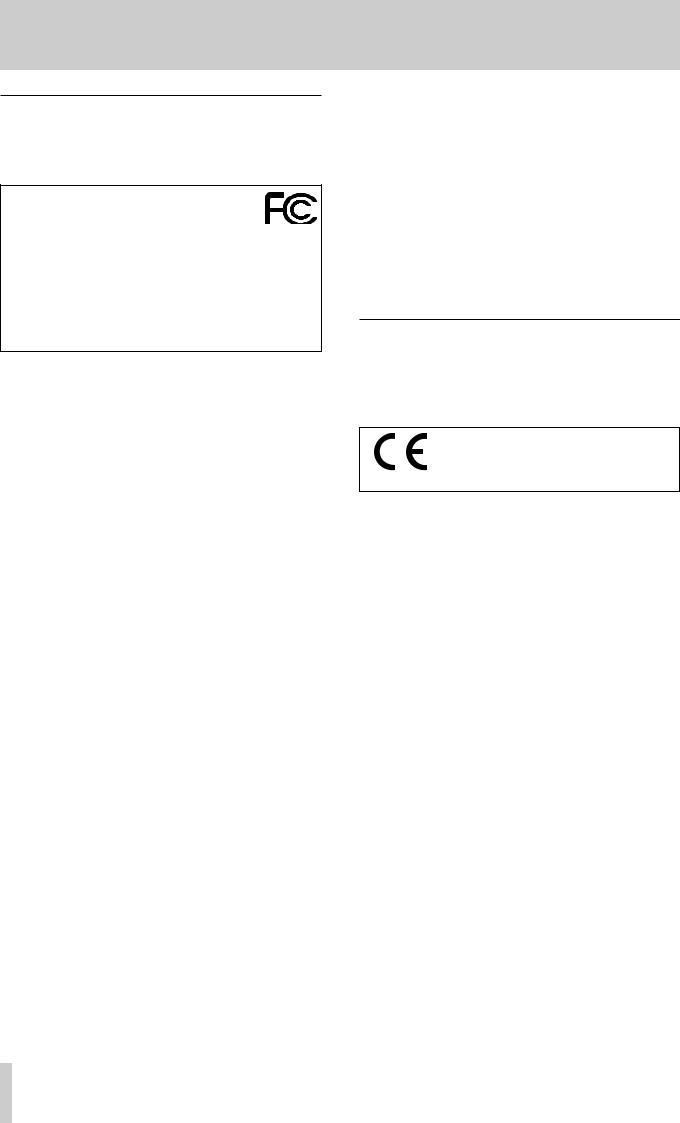
Wireless equipment precautions
Compliance of radio transmitter and interference
Model for USA
Declaration of Conformity
Responsible party: TEAC AMERICA, INC.
Address: 10410 Pioneer Blvd., Unit #1 and #4, Santa Fe Springs, CA 90640, U.S.A.
Telephone number: 1-323-726-0303
This device complies with Part.15 of FCC Rules. Operation is subject to the following two conditions: (1) this device may not cause harmful interference, and (2) this device must accept any interference received, including interference that may cause undesired operation.
Labeling of authorization FCC ID: XEG-MODEL24
Model for Canada
Compliance of radio transmitter
This device complies with Industry Canada RSS-210 standard(s). Operation is subject to the following two conditions:
1)This device may not cause interference
2)This device must accept any interference, including interference that may cause undesired operation of the device.
Labeling of authorization IC: 1559C-MODEL24
Modèle pour le Canada
Conformité de l’émetteur radio
Ce dispositif est conforme à la norme CNR-210 d’Industrie Canada applicable aux appareils radio exempts de licence. Son fonctionnement est sujet aux deux conditions suivantes :
1)Le dispositif ne doit pas produire de brouillage préjudiciable,et
2)Ce dispositif doit accepter tout brouillage reçu, y compris un brouillage susceptible de provoquer un fonctionnement indésirable.
Étiquetage d’autorisation IC: 1559C-MODEL24
Compliance of interference
This Class B digital apparatus complies with Canadian ICES-003.
This equipment complies with FCC/IC radiation exposure limits set forth for an uncontrolled environment and meets the FCC radio frequency (RF) Exposure Guidelines and RSS-102 of the IC radio frequency (RF) Exposure rules. This equipment has very low levels of RF energy that it deemed to comply without maximum permissive exposure evaluation (MPE). But it is desirable that it should be installed and operated keeping the radiator at least 20 cm or more away from person’s body (excluding extremities: hands, wrists, feet and ankles).
Cet équipement est conforme aux limites d’exposition aux rayonnements énoncées pour un environnement non contrôlé et respecte les règles les radioélectriques (RF) de la FCC
lignes directrices d’exposition et d’exposition aux fréquences
radioélectriques (RF) CNR-102 de l’IC. Cet équipement émet une énergie RF très faible qui est considérée conforme sans évaluation de l’exposition maximale autorisée. Cependant, cet équipement doit être installé et utilisé en gardant une distance de 20 cm ou plus entre le dispositif rayonnant et le corps (à l’exception des extrémités : mains, poignets, pieds et chevilles).
Conformité de brouillage
Cet appareil numérique de la classe B est conforme à la norme NMB-003 du Canada.
Marquage d’autorisation
CAN ICES-3(B)/NMB-3(B)
Model for EEA (European Economic Area)
This product has the function of broadband transmitter using 2.4GHz Band.
Use frequency range: 2400 MHz – 2480 MHz
Maximum output power: Bluetooth® Class 2 (less than 2.5 mW)
Hereby, TEAC Corporation declares that the radio equipment type is in compliance with Directive 2014/53/EU., and the other Directives, and Commission Regulations.
The full text of the EU declaration of conformity is available at the following internet address: Please contact us by e-mail.
http://tascam.eu/en/kontakt.html EU Importer: TEAC Europe GmbH
Bahnstrasse 12, 65205 Wiesbaden-Erbenheim, Germany
CAUTION
Authorization of wireless devices are different in countries or regions. Please use only in the country where you purchased the product.
•Depending on the country, restrictions on the use of Bluetooth wireless technology might exist.
Confirm the laws and regulations of the country or region where you want to use the unit before use.
Radiation Exposure requirements
This equipment meets the regulation, which is recognized internationally, for the case of human exposure to radio waves generated by the transmitter.
Statement of compliance
Model for USA
This equipment complies with FCC radiation exposure limits set forth for an uncontrolled environment and meets the FCC radio frequency Exposure Guidelines.
Model for Canada
This equipment complies with IC RSS-102 radiation exposure limits set forth for an uncontrolled environment.
Model for EEA (European Economic Area)
This equipment complies with EN.62311; Assessment of electronic and electrical equipment related to human exposure restrictions for electromagnetic fields; the harmonised standard of DIRECTIVE 2014/53/EU.
6 TASCAM Model 24

Wireless equipment precautions
CAUTION
Changes or modifications not expressly approved by the party responsible for compliance could void the user’s authority to operate the equipment.
Information for interference (FCC requirements)
This equipment has been tested and found to comply with the limits for a Class B digital device, pursuant to Part 15 of the FCC Rules.
These limits are designed to provide reasonable protection against harmful interference in a residential installation.
This equipment generates, uses, and can radiate radio frequency energy and, if not installed and used in accordance with the instructions, may cause harmful interference to radio communications.
However, there is no guarantee that interference will not occur in a particular installation.
If this equipment does cause harmful interference to radio or television reception, which can be determined by turning the equipment off and on, the user is encouraged to try to correct the interference by one or more of the following measures.
•Reorient or relocate the equipment and/or the receiving antenna.
•Increase the separation between the equipment and receiver.
•Connect the equipment into an outlet on a circuit different from that to which the receiver is connected.
•Consult the dealer or an experienced radio/TV technician for help.
TASCAM Model 24 7

Contents |
|
IMPORTANT SAFETY PRECAUTIONS....................................... |
2 |
IMPORTANT SAFETY INSTRUCTIONS...................................... |
3 |
Safety Information................................................................... |
4 |
Wireless equipment precautions............................................ |
6 |
Contents.................................................................................... |
8 |
1 – Introduction...................................................................... |
10 |
Features..................................................................................................... |
10 |
Items included with this product.................................................... |
10 |
Conventions used in this manual.................................................... |
10 |
Trademarks.............................................................................................. |
11 |
Precautions for placement and use................................................ |
11 |
Notes about power supplies............................................................. |
11 |
Beware of condensation..................................................................... |
11 |
Cleaning the unit................................................................................... |
11 |
About SD cards....................................................................................... |
11 |
Precautions for use........................................................................... |
11 |
SD card write protection................................................................ |
11 |
Note about formatting.................................................................... |
11 |
Bluetooth®................................................................................................ |
12 |
Profiles.................................................................................................. |
12 |
Codecs.................................................................................................. |
12 |
Content protection.......................................................................... |
12 |
Transmission security...................................................................... |
12 |
Using the TEAC Global Site................................................................ |
12 |
Product registration............................................................................. |
12 |
About TASCAM customer support service................................... |
12 |
2 – Names and Functions of Parts......................................... |
13 |
Top panel.................................................................................................. |
13 |
Analog input jack section.............................................................. |
14 |
Input channel mixing section...................................................... |
15 |
Analog output jack section........................................................... |
16 |
Screen operation section............................................................... |
16 |
Built-in effects operation section................................................ |
17 |
Analog output adjustment section............................................ |
18 |
Rear panel................................................................................................ |
18 |
Home Screen........................................................................................... |
19 |
Meters Screen......................................................................................... |
19 |
Meter Screen details........................................................................ |
20 |
Menu structure....................................................................................... |
20 |
Basic MENU screen operations......................................................... |
21 |
Menu operation procedures......................................................... |
21 |
3 – Preparation....................................................................... |
22 |
Connecting other equipment........................................................... |
22 |
Connecting microphones.............................................................. |
23 |
Guitars................................................................................................... |
23 |
Connecting electronic devices |
|
and other audio equipment......................................................... |
23 |
Connecting monitor speakers...................................................... |
23 |
Connecting headphones............................................................... |
23 |
Computer connections................................................................... |
23 |
Connecting with Bluetooth devices.......................................... |
23 |
Inserting and removing SD cards.................................................... |
24 |
Inserting SD cards............................................................................. |
24 |
Removing SD cards.......................................................................... |
24 |
SD card write protection switches.............................................. |
24 |
Turning the power on and off........................................................... |
24 |
Setting the built-in clock date and time....................................... |
25 |
Adjusting the display........................................................................... |
25 |
Adjusting the display contrast..................................................... |
25 |
Adjusting the display brightness................................................ |
25 |
Preparing an SD card for use............................................................. |
25 |
4 – Managing Songs............................................................... |
26 |
Viewing the song list............................................................................ |
26 |
Song Operation...................................................................................... |
26 |
Creating a New Song........................................................................... |
26 |
Loading Songs........................................................................................ |
27 |
Viewing song information.................................................................. |
27 |
Deleting songs....................................................................................... |
27 |
Protecting/unprotecting songs....................................................... |
28 |
Editing song names.............................................................................. |
28 |
Editing text.......................................................................................... |
28 |
5 – Basic recording................................................................. |
29 |
Selecting the input source................................................................. |
29 |
Setting the MODE switch................................................................... |
29 |
Setting phantom power..................................................................... |
29 |
Monitoring............................................................................................... |
29 |
SIG indicators and level meters........................................................ |
30 |
Recording................................................................................................. |
30 |
Undoing operations............................................................................. |
31 |
Undoing the previous operation................................................ |
31 |
Using the built-in effects.................................................................... |
31 |
Setting the built-in effect............................................................... |
31 |
6 – Recorder functions........................................................... |
33 |
Locate function...................................................................................... |
33 |
Changing the playback position................................................. |
33 |
Using the direct locate function to locate............................... |
33 |
Repeat playback function.................................................................. |
33 |
Punch in/out function......................................................................... |
33 |
Using the footswitch to punch in/out....................................... |
33 |
Setting up the footswitch.............................................................. |
34 |
Setting the footswitch polarity.................................................... |
34 |
Automatic punch in/out function.................................................. |
34 |
Setting the punch in/out points.................................................. |
34 |
Setting a pre roll point.................................................................... |
35 |
Rehearsing punching in and out................................................. |
35 |
Using automatic punching in and out...................................... |
35 |
7 – Track editing..................................................................... |
36 |
Clearing tracks........................................................................................ |
36 |
Importing tracks.................................................................................... |
36 |
8 – Settings and Information................................................. |
37 |
Viewing information............................................................................. |
37 |
CARD Screen....................................................................................... |
37 |
SONG Screen...................................................................................... |
37 |
FIRMWARE Screen............................................................................. |
37 |
Setting the song name format......................................................... |
37 |
Setting the WORD item.................................................................. |
37 |
Restoring factory default settings................................................... |
38 |
Formatting SD cards............................................................................. |
38 |
Playing WAV files on SD cards (SD PLAY mode).......................... |
39 |
9 –Using a computer to transfer data................................... |
40 |
Connecting with a Computer........................................................... |
40 |
Disconnecting.................................................................................... |
40 |
Loading WAV files from a computer............................................... |
41 |
10 – USB audio interface functions....................................... |
42 |
Installing the dedicated software |
|
(Windows only)...................................................................................... |
42 |
Installing the Windows dedicated software............................ |
42 |
Uninstalling the Windows dedicated software...................... |
43 |
Opening the Settings Panel (Windows only).............................. |
43 |
Windows Settings Panel overview.................................................. |
43 |
Setting Sound Properties................................................................... |
44 |
Simultaneous ASIO/WDM playback............................................... |
44 |
8 TASCAM Model 24

Contents
11 – Messages......................................................................... |
45 |
12 – Troubleshooting............................................................. |
47 |
13 – Specifications.................................................................. |
49 |
General...................................................................................................... |
49 |
Inputs and outputs............................................................................... |
49 |
Analog audio input and output ratings.................................... |
49 |
Control input/output....................................................................... |
50 |
Computer system requirements...................................................... |
50 |
Windows.............................................................................................. |
50 |
Mac......................................................................................................... |
50 |
Supported audio drivers................................................................ |
50 |
Audio performance.............................................................................. |
50 |
Bluetooth.................................................................................................. |
51 |
Other.......................................................................................................... |
51 |
Dimensional drawings......................................................................... |
52 |
Block diagram......................................................................................... |
53 |
Level diagram......................................................................................... |
54 |
TASCAM Model 24 9

1 – Introduction
Thank you very much for purchasing the
TASCAM Model 24 Multitrack Live Recording Console.
Before using this unit, read this Owner’s Manual carefully so that you will be able to use it correctly and enjoy working with it for many years. After you have finished reading this manual, please keep it in a safe place for future reference.
You can also download this Owner’s Manual from the TEAC Global Site (http://teac-global.com/).
Features
0022 input analog mixer with 22 line and 16 mic inputs
00Multitrack recording and playback with 24-track recording (22 input channels and MAIN MIX L/R bus)
00USB audio interface functions built-in
oo24 tracks (22 input channels and MAIN MIX L/R bus) can be input to the computer
oo22 track outputs and computer outputs can be assigned to channel inputs
ooSupports USB 2.0 audio with resolutions up to 24-bit and 48kHz sampling frequency
00Analog compressors included on channel 1-12 inputs 00100mm faders enable precise adjustments
00LINE/INST (BAL) input jacks that support high impedance (Hi-Z) on channels 1-2
00Channel inserts (INSERT) on channels 1-2
00Multiple buses include stereo main (MAIN MIX L/R bus), sub (SUB L/R bus) and monitor (MONITOR OUT 1/2)
003 AUX sends (MON 1/MON 2/FX)
00Input channels have 3-band semi-parametric EQs with adjustable mid frequencies
00Outputs have a 7-band stereo graphic EQs useful for adjusting the mix
0016 TASCAM preset effects can be used for a variety of applications
00Multitrack recording and playback possible using SD cards
00Bluetooth® audio playback and recording supported
00Punching in and out function per track (including punching in and out automatically and with footswitches)
00SD/SDHC cards and SDXC cards (Class 10 or more)
Items included with this product
This product includes the following items.
Take care when opening the package to avoid damaging the items. Keep the packing materials for transportation in the future. Please contact the store where you purchased this unit if any of these items are missing or have been damaged during transportation.
00Main unit................................................................................................ |
× 1 |
00Power cord............................................................................................. |
× 1 |
00Owner’s Manual (this document) including warranty........... |
× 1 |
Conventions used in this manual
In this manual, we use the following conventions:
00When we refer to buttons, connectors and other parts of this unit and other equipment, we use a bold font like this: MENU button.
00When we show characters that appear on the display, the typeface looks like this: MENU .
00The four buttons under the display are called the function buttons. From left to right, they are shown as buttons F1, F2, F3 and F4. Moreover, the functions at the bottoms of the screens will be shown after the button names.
Examples: F1  button, F4
button, F4  button 00SD/SDHC/SDXC memory cards are referred to as “SD cards”.
button 00SD/SDHC/SDXC memory cards are referred to as “SD cards”.
00Computers, portable audio devices and other equipment connected to this unit using Bluetooth are called “Bluetooth devices”.
00Groups of recorded data are referred to as “songs”.
00The song that is currently selected is called the “current song”.
00Information shown on a computer display is written like this:
OK .
00As necessary, additional information is provided under TIP, NOTE and CAUTION headings.
TIP
These are tips about how to use the unit.
NOTE
These provide additional explanations and describe special cases.
ATTENTION
Failure to follow these instructions could result in damage to equipment or lost data, for example.
VCAUTION
Failure to follow these instructions could result in injury.
10 TASCAM Model 24
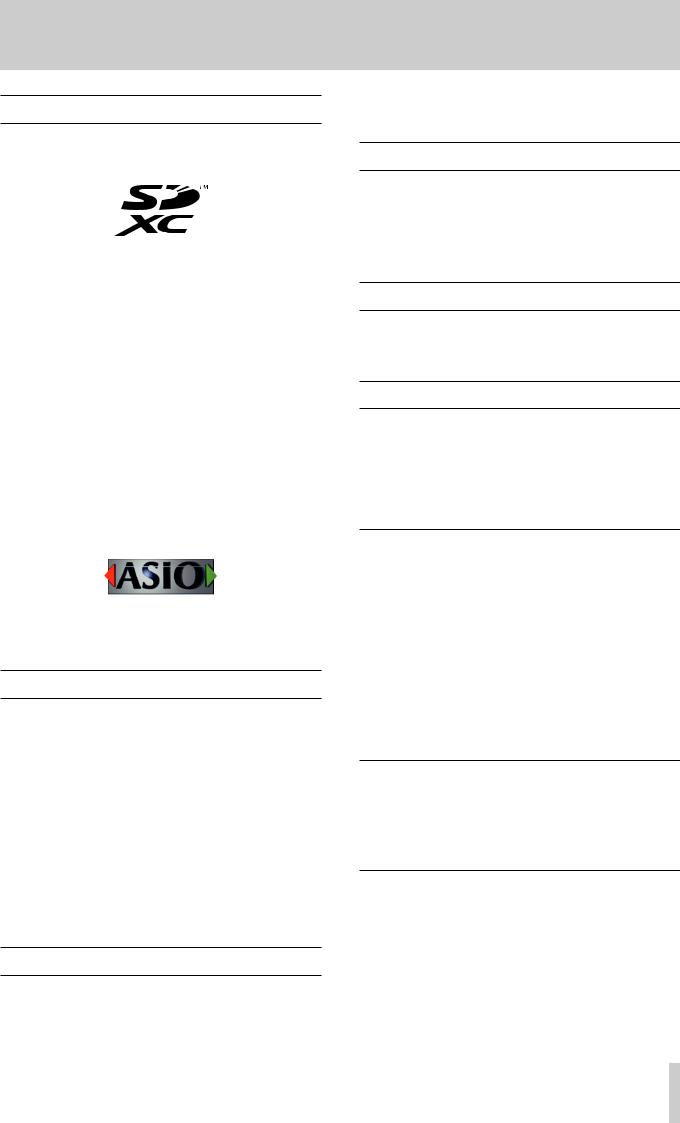
Trademarks
00TASCAM is a registered trademark of TEAC Corporation. 00SDXC Logo is a trademark of SD-3C, LLC.
00The Bluetooth® word mark and logo are the property of Bluetooth SIG, Inc. and are used by TEAC Corporation with permission.
00Supply of this product does not convey a license nor imply any right to distribute MPEG Layer-3 compliant content created with this product in revenue-generating broadcast systems (terrestrial, satellite, cable and/or other distribution channels), streaming applications (via Internet, intranets and/or other networks), other content distribution systems (pay-audio or audio-on-demand applications and the like) or on physical media (compact discs, digital versatile discs, semiconductor chips, hard drives, memory cards and the like). An independent license for such use is required. For details, please visit http://mp3licensing.com.
00Microsoft, Windows and Windows Vista are either registered trademarks or trademarks of Microsoft Corporation in the United States and/or other countries.
00Apple, Mac, Mac OS, macOS, iPad, iPod, iPod touch, Lightning, App Store and iTunes are trademarks of Apple Inc.
00ASIO is a trademark of Steinberg Media Technologies GmbH.
00Other company names, product names and logos in this document are the trademarks or registered trademarks of their respective owners.
Precautions for placement and use
00The operating temperature range of this unit is 5–35 °C.
00Do not install this unit in the following types of locations. Doing so could make the sound quality worse or cause malfunction.
Places with significant vibrations
Next to a window or in another location exposed to direct sunlight
Near heaters or other extremely hot places Extremely cold places
Very humid or poorly ventilated places Very dusty places
00To enable good heat dissipation, do not place anything on top of the unit.
00Do not place the unit on top of a power amplifier or other device that generates heat.
Notes about power supplies
00Insert the included power cord all the way into the AC IN connector.
00Do not connect a power supply other than one that is AC100V - 240V (50/60Hz).
1 – Introduction
00Hold the power cord by its plug when connecting or disconnecting it.
Beware of condensation
Condensation could occur if the unit is moved from a cold place to a warm place, it is used immediately after a cold room has been heated or it is otherwise exposed to a sudden temperature change.
To prevent this, or if this occurs, let the unit sit for one or two hours at the new room temperature before using it.
Cleaning the unit
Use a dry soft cloth to wipe the unit clean. Do not wipe with chemical cleaning cloths, thinner, alcohol or other chemical agents. Doing so could damage the surface or cause discoloration.
About SD cards
This unit uses SD cards for recording and playback.
This unit can use SD cards that are Class 10 or higher and compatible with SD, SDHC or SDXC standards.
A list of SD cards that have been confirmed for use with this unit can be found on our web site. Please access to a product page of this product from the TEAC Global Site (http://teac-global.com) to find the list or contact the TASCAM customer support service.
Precautions for use
SD cards are delicate media.
In order to avoid damaging SD cards, please take the following precautions when handling them.
00Do not leave them in extremely hot or cold places. 00Do not leave them in extremely humid places. 00Do not let them get wet.
00Do not put things on top of them or twist them. 00Do not hit them.
00Do not remove or insert them during recording, playback, data transmission or other access.
00When transporting them, put them into cases, for example.
SD card write protection
This unit writes track information to the media in order to improve operation performance. Since, for example, setting information cannot be written to SD cards that are write-protected, settings will not be retained when the unit is restarted and performance will be otherwise affected.
Note about formatting
SD cards formatted by this unit are optimized to improve performance during recording. Use this unit to format the SD cards to be used with it. Errors might occur when recording with this unit using an SD card formatted by a computer or other device.
TASCAM Model 24 11

1 – Introduction
Bluetooth®
This unit has a built-in Bluetooth audio receiver, and can input sound played on a computer or portable audio device that supports Bluetooth (Bluetooth device).
ATTENTION
The Bluetooth function of this unit is not guaranteed to enable connection or operation with all Bluetooth devices.
Profiles
This unit supports the following Bluetooth profiles. 00A2DP (Advanced Audio Distribution Profile)
In order to transfer audio by Bluetooth, the Bluetooth device must support A2DP.
Even if a Bluetooth device supports the same profiles, though, its functions might differ according to its specifications.
Codecs
This unit supports the following codecs. It will automatically select one of them during audio transfer.
00SBC
00AAC
The unit will select the appropriate codec to use according to the codec compatibility of the other Bluetooth device and communication conditions.
NOTE
iiYou cannot select the codec to be used by pressing a button, for example.
iiDue to characteristics of Bluetooth wireless technology, playback from this unit will be slightly delayed compared to playback from the Bluetooth device.
Content protection
This unit supports SCMS-T as a form of content protection when transmitting audio, so it can play protected audio.
Transmission security
This unit supports security functions during Bluetooth transmission in accordance with the Bluetooth standard specifications, but it does not guarantee the privacy of such transmissions.
TEAC CORPORATION will bear no responsibility should an information leak occur during transmission by Bluetooth.
Using the TEAC Global Site
You can download updates for this unit from the TEAC Global Site:
http://teac-global.com/
In the TASCAM Downloads section, select the desired language to open the Downloads website page for that language.
Product registration
Customers in the USA, please visit the following TASCAM website to register your TASCAM product online.
https://tascam.com/us/
About TASCAM customer support service
TASCAM products are supported and warrantied only in their country/region of purchase.
To receive support after purchase, on the TASCAM Distributors list page of the TEAC Global Site (http:// teac-global.com/), search for the local company or representative for the region where you purchased the product and contact that organization.
When making inquiries, the address (URL) of the shop or web shop where it was purchased and the purchase date are required.
Moreover, the warranty card and proof of purchase might also be necessary.
12 TASCAM Model 24
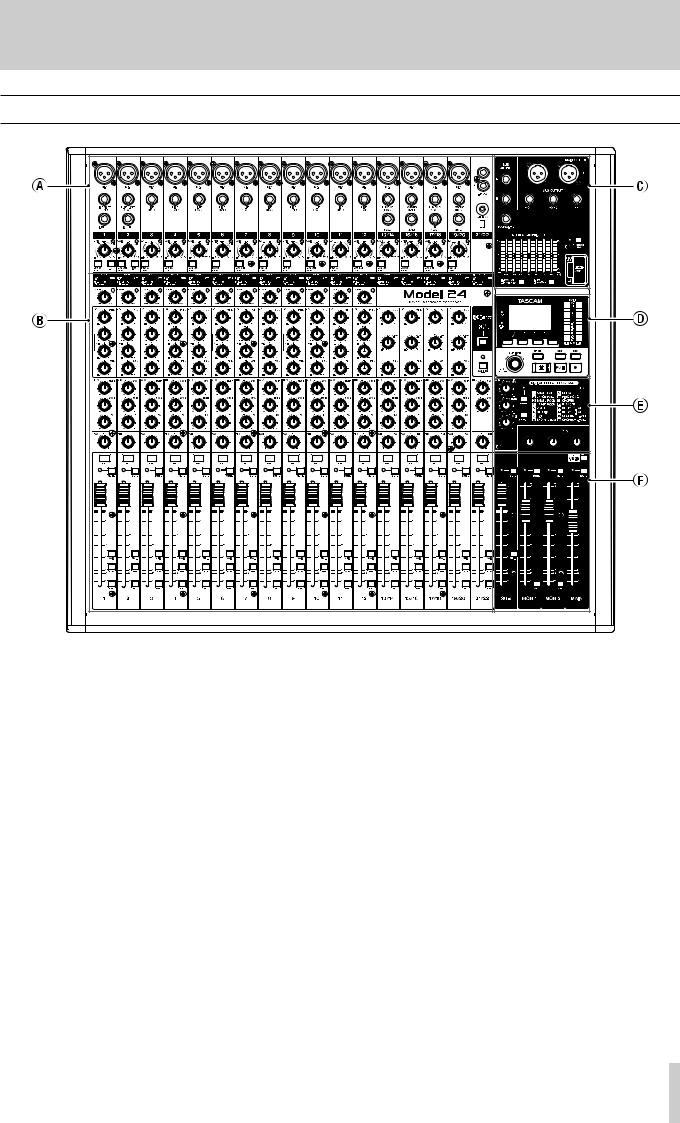
2 – Names and Functions of Parts
Top panel
AAnalog input jack section
Use this section to connect the input jacks for each channel and to adjust the input levels.
BInput channel mixing section
Use this section to choose input sources for each channel, adjust compressors and equalizers, and set levels sent to each bus (MAIN MIX L/R, PFL/AFL L/R, MONITOR OUT 1/2, FX, SUB L/R).
CAnalog output jack section
Use this section to connect the output jacks and adjust the output equalizer.
DScreen operation section
Use this section to operate the meter, home and MENU screens shown on the display.
EBuilt-in effects operation section
Operate the built-in effects and adjust the output levels for each output in this section.
FAnalog output adjustment section
Adjust the output levels from the MAIN OUTPUT, SUB OUTPUT, OUTPUT MON 1 and OUTPUT MON 2 jacks in this section.
TASCAM Model 24 13
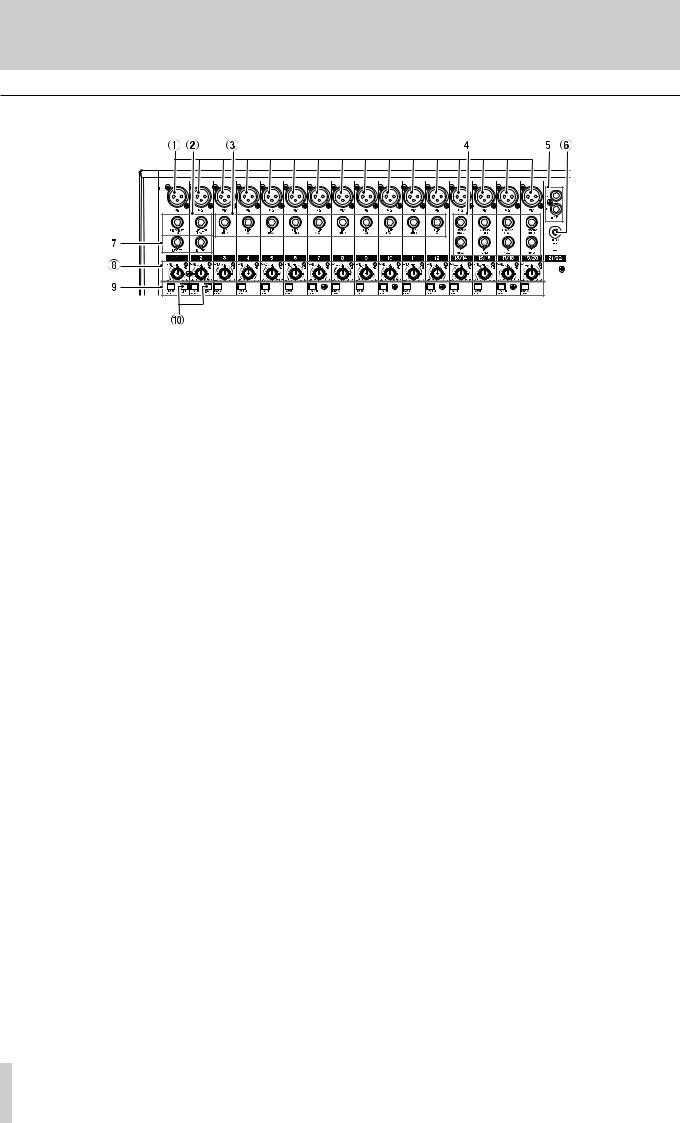
2 – Names and Functions of Parts
Analog input jack section
1MIC input jacks (1-12, 13/14-19/20)
These are balanced XLR jacks for mic input. ooXLR (1: GND, 2: HOT, 3: COLD)
2LINE/INST (BAL) mono input jacks (1-2)
These standard TRS jacks are mono line inputs.
When directly connecting a guitar, bass or other instrument, set the INST switch to on (pushed in).
ooTRS (Tip: HOT, Ring: COLD, Sleeve: GND)
3LINE (BAL) input jacks (3-12)
These standard TRS jacks are line inputs. ooTRS (Tip: HOT, Ring: COLD, Sleeve: GND)
4L/MONO (BAL)/R (BAL) stereo input jacks (13/1419/20)
These standard TRS jacks are stereo line inputs.
If only the L/MONO (BAL) jack in a pair is connected, the same signal was be sent to both left and right channels.
ooTRS (Tip: HOT, Ring: COLD, Sleeve: GND)
5−10dBV (external input) jacks (21/22, RCA pin)
These RCA pin jacks are analog line outputs.
6STEREO input jack (21/22, stereo mini)
This stereo mini jack is a line input jack.
Use this to connect with the line output jack of a tablet or other external device.
7INSERT jacks (1-2, standard)
Use these standard TRS jacks to connect external devices (effects).
ooTRS (Tip: SEND, Ring: RETURN, Sleeve: GND)
8GAIN knobs and SIG indicators (1-12, 13/14-19/20)
Use the GAIN knobs to adjust the input levels of each channel.
its SIG indicator will light green when a signal is input (− 56dB or higher).
If a SIG indicator stays lit red continuously, lower the GAIN knob.
9LOW CUT switches (1-12, 13/14-19/20)
Turn this switch on (pushed in) to enable low cut filters that cut noise and other sounds at low frequencies.
0INST switches (1-2)
Set according to the LINE/INST (BAL) input jack input sources.
Turn the INST switch on (pushed in) when connecting an guitar, bass or other equipment with high output impedance.
Turn the INST switch off (not pushed in) when connecting electronic instruments, audio devices, mics and other equipment.
14 TASCAM Model 24
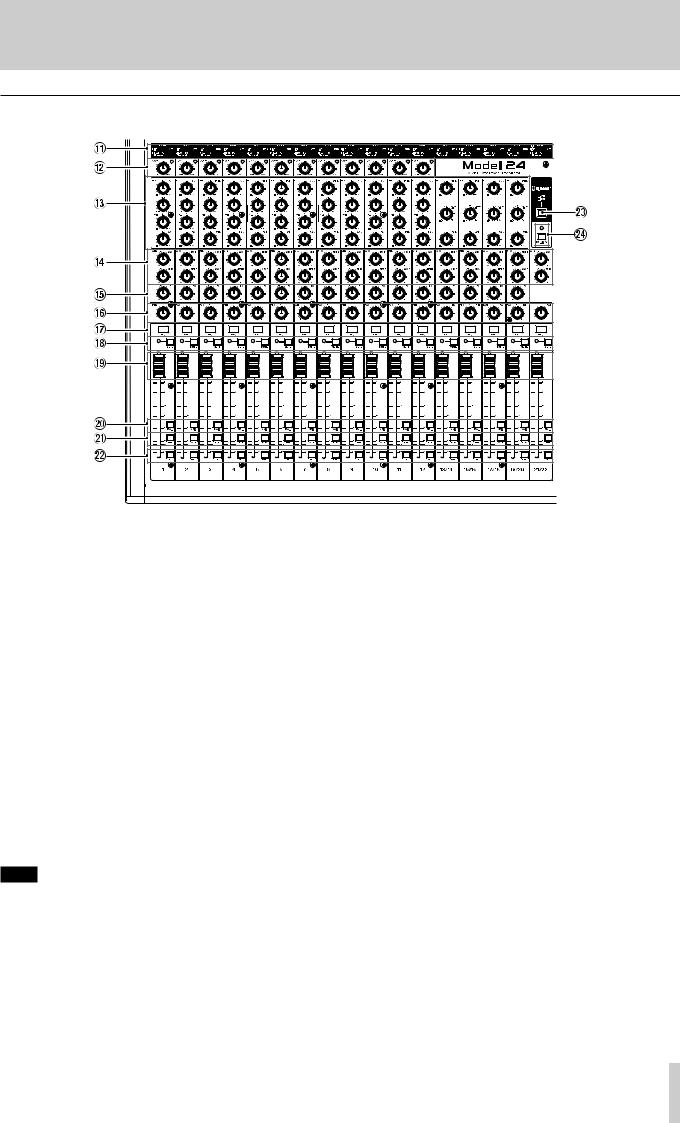
2 – Names and Functions of Parts
Input channel mixing section
QMODE switches (1-12, 13/14-19/20, 21/22)
Use these to select the input source for each channel. (See “Setting the MODE switch” on page 29.)
WCOMP knobs and indicators (1-12)
Use these knobs to adjust the compression of the signals input to each channel.
When compression is activated, the COMP indicators light.
EEQ knobs (1-12, 13/14-19/20)
iiUse these to boost and attenuate the HIGH, MID and LOW bands of each channel.
Setting range: ±15 dB
iiThe cutoff frequencies of the MID bands can be set for channels 1-12.
Setting range: 100Hz – 8kHz (default: 700Hz)
RMON 1/MON 2 knobs (1-12, 13/14-19/20, 21/22)
Use these to adjust the levels of signals sent to the MONITOR OUT 1/2 buses.
TFX knobs (1-12, 13/14-19/20)
Use to adjust the levels of the signals sent to the FX bus.
YPAN knobs (1-12, 13/14-19/20, 21/22)
Use to adjust the stereo positions of the signals input to each channel.
NOTE
iiWhen PAN knobs are centered (C), signals are reduced by 3 dB and sent to both left and right MAIN MIX L/R buses.
iiWhen a PAN knob is turned all the way to the left (L), that channel signal is sent only to the left MAIN MIX L/R bus. It is not sent to the right bus.
iiWhen a PAN knob is turned all the way to the right (R), that channel signal is sent only to the right MAIN MIX L/R bus. It is not sent to the left bus.
UREC buttons and indicators (1-12, 13/14-19/20, 21/22)
Use these to select the channels to record to the SD card.
IMUTE switches and indicators (1-12, 13/14-19/20, 21/22)
When these switches are on (pushed in, MUTE indicator lit), those channels are muted.
OChannel faders (1-12, 13/14-19/20, 21/22)
Use these to adjust the send levels of channel signals.
PMAIN switches (1-12, 13/14-19/20, 21/22)
Turn these switches on (pushed in) to send channel signals to the MAIN MIX L/R bus.
ASUB switches (1-12, 13/14-19/20, 21/22)
Turn these switches on (pushed in) to send channel signals to the SUB L/R bus.
SPFL switches (1-12, 13/14-19/20, 21/22)
Turn these switches on (pushed in) to send channel signals to the PFL/AFL L/R bus.
DON/MUTE switches
Turn this switch “ON” to input audio from a paired Bluetooth device.
FPAIRING button and indicator
Press and hold this button to activate Bluetooth pairing mode.
Press when pairing to end pairing mode. (See “Connecting with Bluetooth devices” on page 23.)
TASCAM Model 24 15
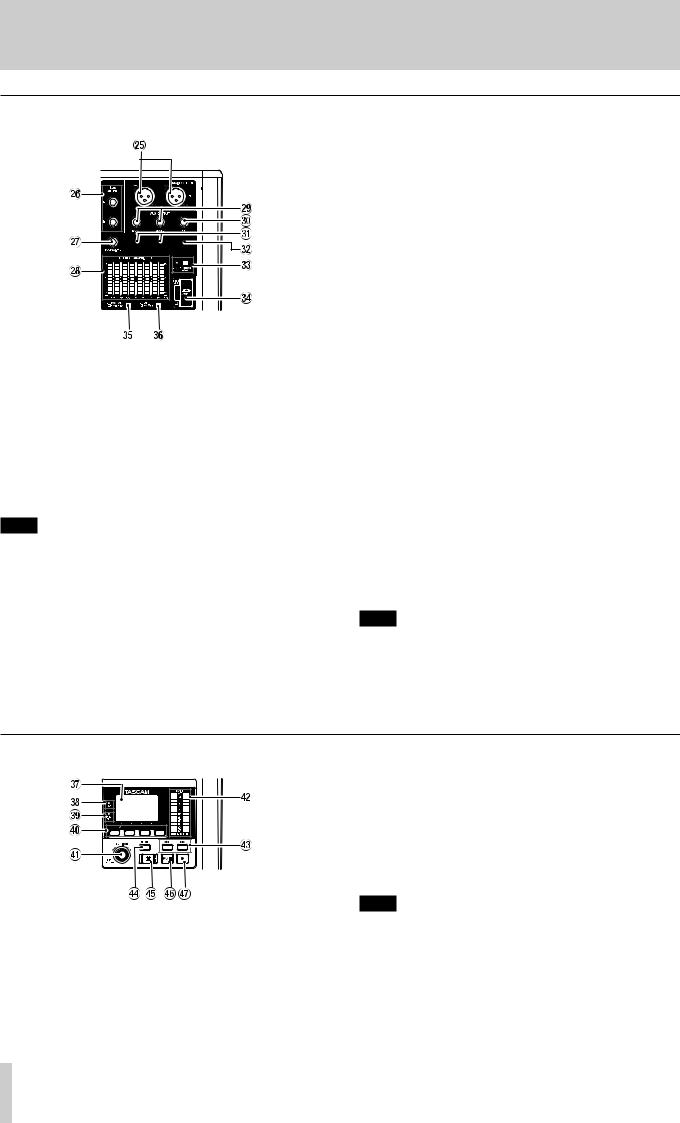
2 – Names and Functions of Parts
Analog output jack section
GMAIN OUTPUT L/R jacks
These analog outputs are XLR jacks.
ooXLR (1: GND, 2: HOT, 3: COLD)
HSUB OUTPUT L/R jacks
These standard TRS jacks are analog outputs. ooTRS (Tip: HOT, Ring: COLD, Sleeve: GND)
JFOOTSWITCH jack
This standard TS jack is for connecting a footswitch. ooTS (Tip: HOT, Sleeve: GND)
NOTE
This unit was designed to be used with unlatched (momentary) footswitches that have to be pushed to function (shorted when pushed).
KSTEREO GRAPHIC EQ faders
This 7-band graphic equalizer affects signals output from the
MAIN OUTPUT and AUX OUTPUT MON 1/2 jacks.
LAUX OUTPUT MON 1/2 jacks
These standard TRS jacks are analog outputs. ooTRS (Tip: HOT, Ring: COLD, Sleeve: GND)
;FX OUTPUT jack
This standard TRS jack is an analog output.
When an external effect is connected, signals will not be sent to the built-in effect.
When using an external effect, turn the built-in effect off.
ooTRS (Tip: HOT, Ring: COLD, Sleeve: GND)
ZCONTROL ROOM L/R jacks
These standard TRS jacks are analog outputs.
Use these to monitor signals from the MAIN MIX L/R bus or PFL/AFL L/R bus.
ooTRS (Tip: HOT, Ring: COLD, Sleeve: GND)
XPHONES jack
Use this standard stereo jack to connect stereo headphones. Use an adapter to connect headphones with a mini plug.
Use this to monitor signals from the MAIN MIX L/R bus or PFL/ AFL L/R bus.
CPHANTOM +48V switch and indicator
Use this switch to supply +48V phantom power to the 1-2, 3-12 and 13/14-19/20 MIC input jacks on the top of the unit.
The indicator lights when the PHANTOM +48V switch is set to on (pushed in). (See “Setting phantom power” on page 29.)
VSD card slot
Insert SD cards in these slots. (See “Inserting and removing SD cards” on page 24.)
BMON 1/2/MAIN MIX switch
Set which output signals are affected by the equalizer.
MANI MIX: Equalizer is applied to signals sent from the MAIN MIX L/R bus.
MON 1/2: Equalizer is applied to signals sent from the MONITOR OUT 1/2 buses.
NOTE
Set the EQ IN/BYPASS switch to EQ IN also.
NEQ IN/BYPASS switch
When this switch is EQ IN, the equalizer will affect the output signals set with the MON 1/2/MAIN MIX switch.
When BYPASS, the equalizer will not be applied regardless of the MON 1/2/MAIN MIX switch setting.
Screen operation section
MDisplay
Shows a variety of information.
,USB indicator
This lights when the USB connection is working.
.PFL/AFL indicator
This indicator lights when either at least one channel PFL switch is on (pushed in) or when the MON 1/MON 2 fader AFL switch is on (pushed in).
/Function buttons
The functions of these buttons change depending on the screen shown on the display. The functions shown at the bottom of the display are the currently assigned functions.
NOTE
For convenience, the four buttons under the display are called the function buttons in this manual. From left to right, they are called the F1, F2, F3 and F4 buttons.
16 TASCAM Model 24

2 – Names and Functions of Parts
!MULTI JOG dial
This dial functions as a dial when turned and as a button when pressed.
Dial functions
iiTurn when the Home Screen is open to move the file playback position. (See “Locate function” on page 33.)
iiWhen a MENU Screen is open, turn to select items and change setting values. (See “Basic MENU screen operations” on page 21.)
Button function
iiPress when the Home Screen is open to designate a locate point. (See “Locate function” on page 33.)
iiWhen a Menu Screen is open, press to confirm selections and settings (ENTER button function).
@Output level indicators
These are output level indicators for the MAIN OUTPUT jacks.
#m/,buttons
iiWhen stopped and during playback, press and hold these buttons to search backward/forward.
iiWhen the Home Screen is open, press the mbutton to locate to the beginning of the current song (00:00:00, which is the zero point).
iiWhen the Home Screen is open, press the , button to locate to the end of the current song.
iiIf the current song has auto punch in or out points set, you can also locate to those points.
iiWhile pressing the 8 button, press the m button to locate to the point where recording last started.
iiWhile pressing the 8 button, press the , button to locate to the point where recording last stopped.
iiWhen the SD PLAY Screen is in playback state, press to skip a file. (See “Playing WAV files on SD cards (SD PLAY mode)” on page 39.)
$MENU button
iiWhen the Meter Screen is open, press to open the Home Screen.
iiWhen the MENU Screen or a menu item settings screen is open, press to return to the Home Screen.
iiWhen the Home Screen is open, press to open the MENU Screen. (See “Menu structure” on page 20.) and (See “Basic MENU screen operations” on page 21.)
%8button/indicator
Press to stop playback or recording. This button lights when stopped.
Press this button when paused to return to the beginning of the song or file.
^7/9button/indicator
Press this button to start playback.
This button lights during playback and recording. This button blinks when paused.
&0button/indicator
Press this button to start recording. This button lights during recording.
Press this button during playback to start recording (Manual punch in).
Built-in effects operation section
R PHONES knob
Use this to adjust the headphone output level.
VCAUTION
Before connecting headphones, minimize the volume with the PHONES knob. Failure to do so could result in a sudden loud noise that could harm hearing, for example.
*MUTE switch/indicator
When the MUTE switch is on (pushed in, MUTE indicator lit), the signal from the built-in effect is muted.
(TO MON 1/TO MON 2 knobs
Use these to adjust the levels of signals sent from the built-in effects to the MONITOR OUT 1/2 buses.
)TO MAIN LR knob
Use these to adjust the levels of signals sent from the built-in effects to the MAIN MIX L/R buses.
QSELECT button
Open the EFFECT Screen and make built-in effect settings. (See “Using the built-in effects” on page 31.)
The built-in effect return signal is return to the MAIN MIX L/R bus and MONITOR OUT 1/2 buses.
WPFL/AFL MASTER knob
Use these to adjust the send level from the PFL/AFL L/R bus.
ECONTROL ROOM knob
Use to adjust the output levels of the CONTROL ROOM L/R jacks.
TASCAM Model 24 17
